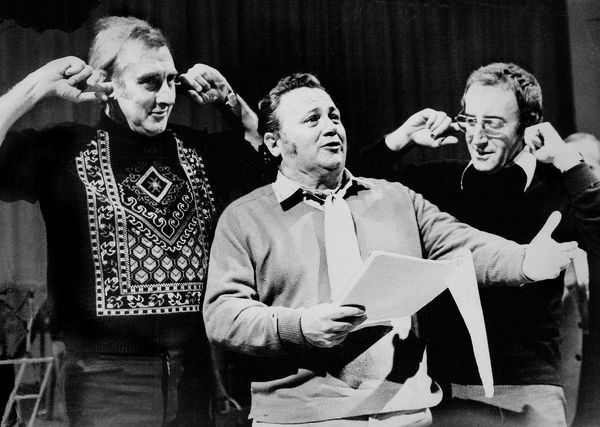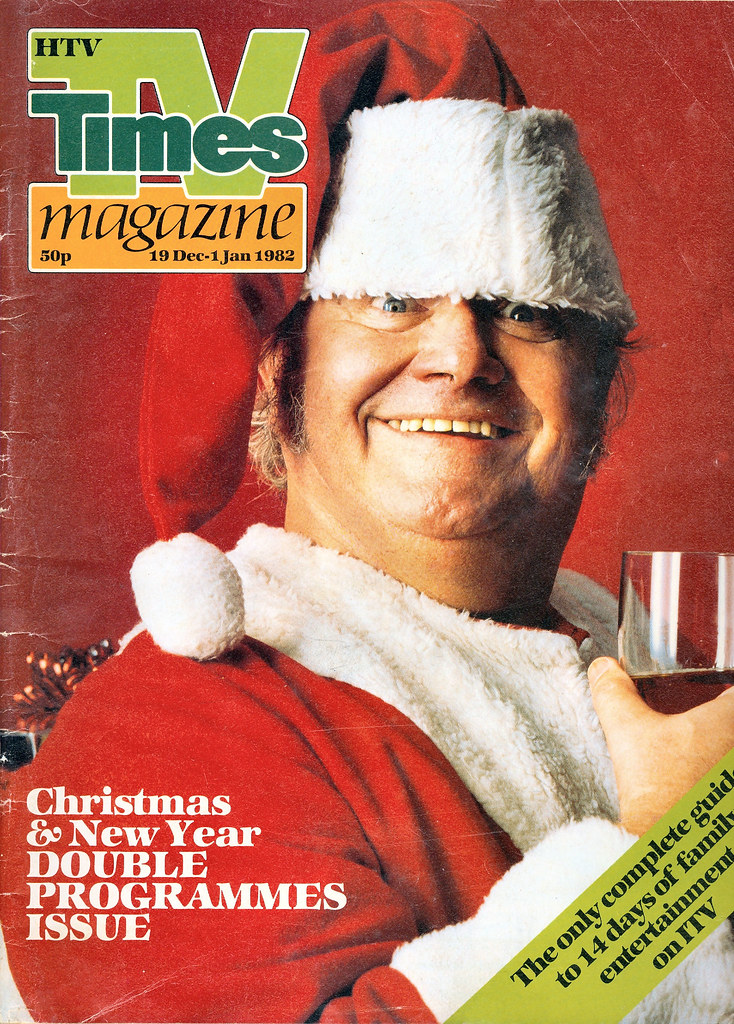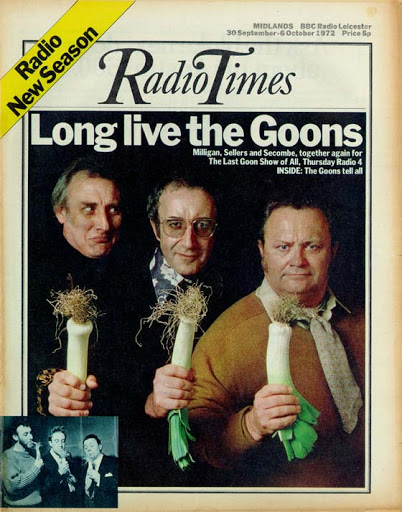Harry Secombe

HARRY SECOMBE was a much-loved Welsh comedian, actor and singer, famed as a member of the British post-War radio comedy programme The Goon Show.
He starred alongside Peter Sellers and Spike Millgan on The Goon Show from 1951 to 1960, playing many characters, but most notably, Neddie Seagoon, with catchphrases such as “needle-nardle-noo” or “what, what, what what, what!” becoming universally known.
An accomplished tenor, he also appeared in musicals and films – notably as Mr Bumble in Oliver! – and, in his later years, was a presenter of television shows incorporating hymns and other devotional songs.
Secombe was born on September 8, 1921, in St Thomas, Swansea, the third of four children and from the age of 11 he attended Dynevor School, a state grammar school in central Swansea.
His family were regular churchgoers, belonging to the congregation of St Thomas Church. A member of the choir, from the age of 12, Secombe would perform a sketch entitled The Welsh Courtship at church socials, acting as ‘feed’ to his sister Carol. His elder brother, Fred, was the author of several books about his experiences as an Anglican priest and rector.
After leaving school in 1937, Secombe became a pay clerk at Baldwin’s store. With war looming, he decided in 1938 that he would join the Territorial Army. Very short-sighted, he got a friend to tell him the sight test, and then learnt it by heart.
He served as a Lance Bombardier in No 132 Field Regiment of the Royal Artillery. He would refer to the unit in which he served during the Second World War in the North African Campaign, Sicily and Italy, as “The Five-Mile Snipers”. While in North Africa Secombe met Milligan for the first time. In Sicily he joined a concert party and developed his own comedy routines to entertain the troops.

When Secombe visited the Falkland Islands to entertain the troops after the 1982 Falklands War, his old regiment promoted him to the rank of sergeant – 37 years after he had been demobbed.
He made his first radio broadcast in May 1944 on a variety show aimed at the services. Following the end of fighting in the War, but prior to demobilisation, Secombe joined a pool of entertainers in Naples and formed a comedy duo with Milligan.
Secombe joined the cast of the Windmill Theatre in 1946, using a routine he had developed in Italy about how people shaved. Secombe often claimed that his ability to sing could always be counted on to save him when he bombed on stage.
After a regional touring career, his first break came in radio when he was chosen as resident comedian for the Welsh series Welsh Rarebit, followed by appearances on Variety Bandbox and a regular role in Educating Archie.
Secombe met Michael Bentine at the Windmill Theatre and was introduced to Sellers by his agent Jimmy Grafton. Both Milligan and Sellers credited him with keeping the act on the bill when club owners had wanted to sack them.
Together with Milligan, the four wrote a comedy radio script, and Those Crazy People was commissioned and first broadcast on May 28, 1951. Produced by Dennis Main Wilson, this would soon become The Goon Show and the show remained on the air for nine years. Secombe mainly played the raspberry-blowing Neddie Seagoon, around whom the show’s absurd plots developed.
The Goon Show was described by the BBC’s Martin Dempsey as a “category-defying, post-war radio comedy that has influenced everything from Monty Python to The Mighty Boosh, crafted by Harry together with Peter Sellers and Spike Milligan. But while one had the voices and the other the sheer insanity, it was Harry’s cheery, indefatigable and perpetually dogged Neddie Seagoon who braced the whole show together.”

In 1955, whilst appearing on The Goon Show, Secombe was approached by the BBC to step in at short notice to take the lead in the radio comedy Hancock’s Half Hour.
The star of the show, Tony Hancock, had decided to take an unannounced break abroad the day before the live airing of the second season. Secombe appeared in the lead for the first three episodes and had a guest role in the fourth after Hancock’s return.
All four episodes are lost, but following the discovery of the original scripts the episodes were rerecorded in 2017, with Andrew Secombe performing the role held by his then late father.
With the success of The Goon Show, Secombe developed a dual career as both a comedy actor and a singer. At the beginning of his career as an entertainer his act would end with a joke version of the duet Sweethearts, in which he sang both the baritone and falsetto parts.
Trained under Italian maestro Manlio di Veroli, he emerged as a bel canto tenor (characteristically, he insisted that in his case this meant “can belto”) and had a long list of best-selling record albums to his credit.
In 1958, he appeared in the film Jet Storm, which starred Dame Sybil Thorndike and Richard Attenborough and in the same year Secombe starred in the title role in Davy, one of Ealing Studios’ last films.
The power of his voice allowed Secombe to appear in many stage musicals. This included 1963’s Pickwick, based on Charles Dickens’ The Pickwick Papers, which gave him the number 18 hit single If I Ruled the World – his later signature tune.
In 1965, the show was produced on tour in the United States, where on Broadway he garnered a nomination for a Tony Award for Best Actor in a Musical. Secombe scored his biggest hit single in 1967 with his version of This Is My Song, which peaked at No 2 on the charts in April 1967 while a recording by Petula Clark, which had hit No 1 in February, was still in the top 10.
He also appeared in the musical The Four Musketeers (1967) at Drury Lane, as Mr Bumble in Carol Reed’s film of Oliver! (1968) and in the Envy segment of The Magnificent Seven Deadly Sins (1971).
He would go on to star in his own television show, The Harry Secombe Show, which debuted on Christmas Day 1968 on BBC 1 and ran for 31 episodes until 1973. A sketch comedy show featuring Julian Orchard as Secombe’s regular sidekick, the series also featured guest appearances by fellow Goon Milligan as well as leading performers such as Ronnie Barker and Arthur Lowe.
Secombe later starred in similar vehicles such as Sing a Song of Secombe and ITV’s Secombe with Music during the 1970s, putting his mighty singing voice to good use.
Later in life, Secombe attracted new audiences as a presenter of religious programmes, such as the BBC’s Songs of Praise and ITV’s Stars on Sunday and Highway. He was also a special programming consultant to Harlech Television and hosted a Thames Television programme in 1979 entitled Cross on the Donkey’s Back.
In the latter half of the 1980s, Secombe personally sponsored a football team for boys aged 9–11 in the local West Sutton Little League, ‘Secombe’s Knights’.
In 1990, he was one of a few to be honoured by a second appearance on This Is Your Life, when he was surprised by Michael Aspel at a book signing in a London branch of WH Smith. Secombe had been a subject of the show previously in March 1958 when Eamonn Andrews surprised him at the BBC Television Theatre.
In 1963, he was appointed a Commander of the Order of the British Empire (CBE). He was knighted in 1981, and jokingly referred to himself as Sir Cumference (in recognition of his rotund figure). The motto he chose for his coat of arms was ‘GO ON’, a reference to The Goon Show.
Secombe suffered from peritonitis in 1980. Within two years, taking advice from doctors, he had lost five stones in weight. He had a stroke in 1997, from which he made a slow recovery. He was then diagnosed with prostate cancer in September 1998. After suffering a second stroke in 1999, he was forced to abandon his television career, but made a documentary about his condition in the hope of giving encouragement to other sufferers. Secombe had diabetes in the latter part of his life.
Secombe died on April 11, 2001, at the age of 79, from prostate cancer, in hospital in Guildford, Surrey. His ashes are interred at the parish church of Shamley Green, and a later memorial service to celebrate his life was held at Westminster Abbey on October 26, 2001.
As well as family members and friends, the service was also attended by Charles, Prince of Wales – a well-known fan of The Goon Show – and representatives of Prince Philip, Duke of Edinburgh, Anne, Princess Royal, Princess Margaret, Countess of Snowdon and Prince Edward, Duke of Kent. On his tombstone is the inscription: ‘To know him was to love him.’

Upon hearing of his old friend’s death, Spike Milligan quipped, “I’m glad he died before me, because I didn’t want him to sing at my funeral.” But Secombe would have the last laugh: upon Milligan’s own death the following year, a recording of Secombe singing was played at Spike’s memorial service.
The Secombe Theatre at Sutton, London, bears his name in memory of this former local personality. He is also fondly remembered at the London Welsh Centre, where he opened the bar on St Patrick’s Day (17 March) 1971.
Secombe met Myra Joan Atherton at the Mumbles Dance hall in 1946. The couple were married from 1948 until his death, and had four children.
BACK TO HOME PAGE